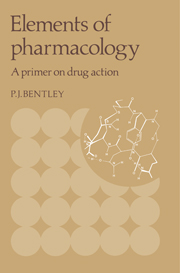Book contents
- Frontmatter
- Contents
- Preface
- 1 Introduction
- 2 Scope of pharmacology
- 3 Where do drugs come from?
- 4 The names of drugs
- 5 Techniques and methods of pharmacology
- 6 Absorption, distribution, and elimination of drugs; pharmacokinetics
- 7 The nature of responses to drugs
- 8 Receptor theory
- 9 Relationship of chemical structure to biological activity
- 10 Roles of the cell membrane in responses to drugs
- 11 Clinical aspects of the actions of drugs
- 12 Conclusion
- References
- Glossary of drugs named in the text
- Index
5 - Techniques and methods of pharmacology
Published online by Cambridge University Press: 29 January 2010
- Frontmatter
- Contents
- Preface
- 1 Introduction
- 2 Scope of pharmacology
- 3 Where do drugs come from?
- 4 The names of drugs
- 5 Techniques and methods of pharmacology
- 6 Absorption, distribution, and elimination of drugs; pharmacokinetics
- 7 The nature of responses to drugs
- 8 Receptor theory
- 9 Relationship of chemical structure to biological activity
- 10 Roles of the cell membrane in responses to drugs
- 11 Clinical aspects of the actions of drugs
- 12 Conclusion
- References
- Glossary of drugs named in the text
- Index
Summary
Pharmacology, like most other sciences, has the ultimate intention of describing its subject (drugs) in terms of chemistry and physics. It is, however, a biological science and so is concerned with the responses of living systems. For this type of work pharmacology has borrowed techniques from physiology and microbiology but has also developed some methods that are peculiarly its own. Because these procedures utilize changes in the activity of living tissues and cells to make measurements, they are called bioassays. The results are expressed in terms of arbitrary units, often agreed upon by international committees. These techniques are useful both in research and in the therapeutic application of pharmacology where they are also used for purposes of identification and to confirm purity. Before the era of the chemical preparation of drugs, most medicines were obtained in a relatively impure condition, often as minor components of complex mixtures with other substances. In addition, their chemical nature was usually unknown. Moreover, even when structure is known, chemical analysis is not always feasible. Bioassays may then be useful, and are often essential.
If properly designed almost any type of biological response can be used to give a parameter that can be expressed in quantitative terms. Such methods may involve an intact (in vivo) animal and utilize responses that are as crude as its death, convulsions, or vomiting; or a change in its blood pressure, urine flow, or the levels of metabolites, such as glucose, in the blood. The survival and rates of growth of cultures of microorganisms can also be used for bioassay.
- Type
- Chapter
- Information
- Elements of PharmacologyA Primer on Drug Action, pp. 10 - 11Publisher: Cambridge University PressPrint publication year: 1981



